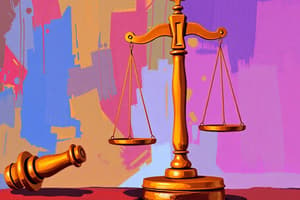Podcast
Questions and Answers
How is law created?
How is law created?
- By treaties
- By constitution (correct)
- By statutes (correct)
- By court decisions (correct)
What is constitutional law?
What is constitutional law?
Limitation on government authority that protects certain rights of citizens.
What does the First Amendment protect?
What does the First Amendment protect?
Freedom.
What does the Fourth Amendment protect?
What does the Fourth Amendment protect?
What is administrative law?
What is administrative law?
What is the function of the National Labor Relations Board (NLRB)?
What is the function of the National Labor Relations Board (NLRB)?
What is common law?
What is common law?
What is binding precedent?
What is binding precedent?
What is a case of first impression?
What is a case of first impression?
What is persuasive precedent?
What is persuasive precedent?
Match the following court systems:
Match the following court systems:
What is jurisdiction?
What is jurisdiction?
What does jurisdiction depend on?
What does jurisdiction depend on?
What is statutory law?
What is statutory law?
Who is a plaintiff?
Who is a plaintiff?
Who is a defendant?
Who is a defendant?
What is a class action?
What is a class action?
What is the statute of limitations?
What is the statute of limitations?
When are motions requested?
When are motions requested?
What is a motion for summary judgment?
What is a motion for summary judgment?
What are court decisions?
What are court decisions?
What are the four sections of a case brief?
What are the four sections of a case brief?
What is a tort?
What is a tort?
What are intentional torts?
What are intentional torts?
What are unintentional torts?
What are unintentional torts?
What is negligence?
What is negligence?
What are the four elements necessary to prove negligence?
What are the four elements necessary to prove negligence?
What is duty in negligence?
What is duty in negligence?
What is breach of duty?
What is breach of duty?
What are injury or damages in negligence?
What are injury or damages in negligence?
What is proximate cause/causation?
What is proximate cause/causation?
Flashcards are hidden until you start studying
Study Notes
Creation of Law
- Law is created through various sources, including the Constitution (federal and state levels), statutes, court decisions (common law), and regulations from administrative agencies.
Constitutional Law
- Constitutional law imposes limitations on government authority, safeguarding citizens' rights.
First Amendment
- Guarantees freedoms concerning religion, expression, assembly, and the right to petition the government.
Fourth Amendment
- Protects citizens from unreasonable searches and seizures, ensuring privacy rights.
Administrative Law
- Administrative laws are developed by agencies tasked with managing and enforcing specific federal laws, with agency regulations holding the force of law.
National Labor Relations Board (NLRB)
- A federal agency responsible for protecting employees' rights to unionize and addressing unfair labor practices by employers and unions in the private sector.
Common Law
- Derived from court decisions, common law evolves based on judicial rulings over time.
Binding Precedent
- Courts within the same system are obligated to follow decisions made by higher courts in that system, ensuring consistency in legal rulings.
Case of First Impression
- Occurs when a court encounters a legal issue without existing precedent to guide its decision.
Persuasive Precedent
- Judicial decisions from other jurisdictions that are influential but not obligatory for a court to follow.
Typical State Court System
- Comprises a hierarchy including the state supreme court, court of appeals, and various special and district courts (family, traffic, criminal, civil).
Federal Court System
- Includes the U.S. Supreme Court, court of appeals, and administrative agencies, with specialized jurisdiction.
Jurisdiction
- Refers to a court's authority to hear and decide cases, influenced by the parties, issues, amount in controversy, and location of events.
Statutory Law
- Created by legislative bodies, applicable only within their governed areas, and can lead to common law when courts interpret disagreements over such laws.
Plaintiff
- The individual or entity that initiates legal proceedings in a lawsuit.
Defendant
- The individual or group being accused or charged in a legal case.
Class Action
- A legal procedure allowing a group of similarly situated litigants to collectively present their case in a single lawsuit.
Statute of Limitations
- Establishes the maximum time frame within which a legal action must be initiated.
Motions
- Requests made by a plaintiff or defendant for the court to perform a specific action concerning their case.
Motion for Summary Judgment
- A legal request for a judge to decide the case based on undisputed facts, eliminating the necessity for a trial.
Court Decisions
- Can be affirmed, reversed, or remanded, impacting the outcome and legal interpretation of cases.
Case Brief Components
- A case brief typically encapsulates four segments: facts, issues, holding, and reasoning.
Tort Law
- Refers to civil wrongs that warrant legal remedy through damages, distinct from criminal law.
Intentional Torts
- Include actions such as assault, battery, and defamation where harm is purposefully inflicted.
Unintentional Torts
- Primarily involve negligence, where harm results from a lack of reasonable care.
Negligence
- Arises when conduct falls short of the legal standard for protecting others from unreasonable harm, encompassing both acts of commission and omission.
Elements of Negligence
- Requires establishing:
- Duty owed to the plaintiff
- Breach of that duty
- Existence of injury or damages
- Proximate cause linking the breach to the injury
Duty
- The legal obligation of the defendant to safeguard the plaintiff from unreasonable risk.
Breach of Duty
- Occurs when the defendant fails to uphold the required legal standard of care.
Injury or Damages
- Essential to prove that the plaintiff has suffered actual harm or damages.
Proximate Cause/Causation
- The breach of duty directly results in the plaintiff's injuries or damages.
Inherent/Special Relationship
- Duty emerges from the nature of the relationship, such as between a coach and athlete or health club and patrons.
Studying That Suits You
Use AI to generate personalized quizzes and flashcards to suit your learning preferences.




